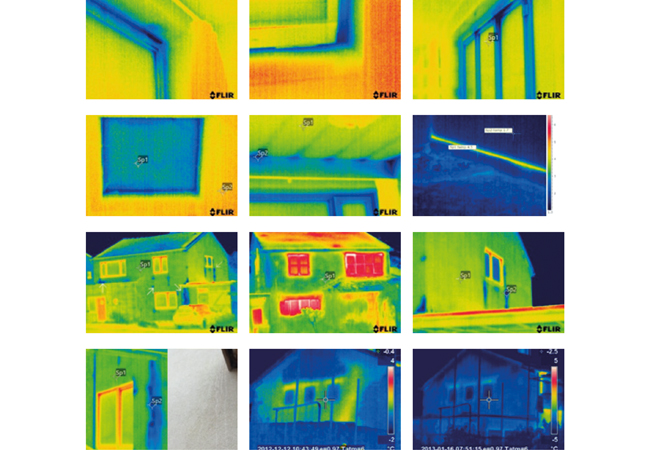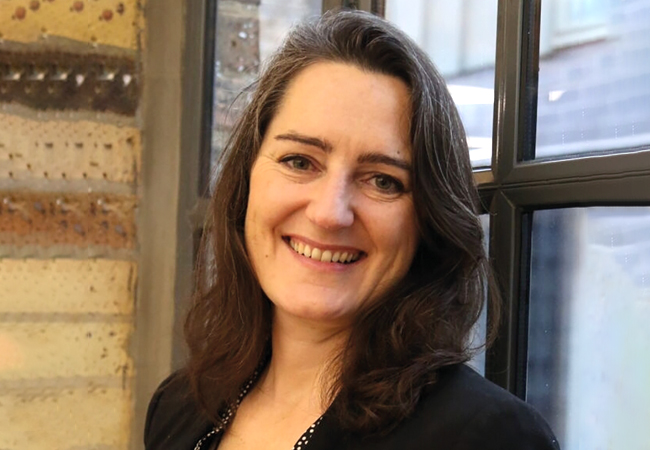
Thermal images showing minimal heat losses of retrofit compared with unrefurbished neighbour (centre)
Retrofit Revisit is a building performance evaluation (BPE) of 10 retrofitted homes, approximately 10 years after the original retrofit works.
The project took place over winter 2022-23, and aimed to gather lessons on retrofit and building performance techniques, which have moved on considerably in 10 years.
Its report looks at how robust, meaningful and useful data are collected in an affordable and accessible manner, and is intended to give occupants, designers and decision-makers a good understanding of BPE.
Analysis of the homes aimed to find out what had stood the test of time, and what lessons there were to learn. The team was particularly interested in moisture, insulation options (moisture and combustibility), and the degradation of original solutions (for example, fabric condition and airtightness).
The retrofit has delivered long-term benefits, with energy use still significantly lower than in the average stock
All 10 sample homes were considered best practice or exemplar at the time, and employed a whole-house ‘deep’ retrofit approach. Six were part of the 2009-13 Retrofit for the Future programme.
Six of the properties dated from pre-1919, nine were houses (one a flat), and they were a mix of housing association and privately owned properties.
Their insulation strategies varied, with a mix of external, internal and cavity insulation, and permeable and impermeable materials. Heating, hot water and ventilation systems were also varied.
A two-tiered BPE approach – core and detailed scope – was followed for the project.
There were two approaches: core and detailed scope. The core scope covered all case studies and included a Soap retrofit questionnaire, an energy audit, and one month of winter monitoring, including energy readings, temperature and relative humidity. There was also SmartHTC (heat transfer coefficient) tests, a BTS mould risk indicator, and blower door and pulse airtightness testing. The detailed scope covered four to five case studies and included independent testing of airtightness tests. Thermal performance evaluation included: plate U-value measurement; Heat3D U-value measurement; thermal imaging; and independent expert advice. For moisture, there was: WUFI modelling; interstitial moisture risk assessment; independent expert advice; and physical testing for moisture content, mould spore count in ambient and cavity air and moisture content of fabric.Building performance evaluation techniques
The results:
Energy performance
In most of the homes, no major change has been observed in energy performance compared with the original retrofit energy use. The retrofit has delivered long-term benefits, with energy use still significantly lower than in the average stock.
Tellingly, most homes have reported being satisfied or very satisfied with their energy bills. Where space-heating demand could be estimated, it is in line with best practice retrofit standards, significantly below the national average.
The energy use intensity (EUI) is, on average, ~80kWh·m-2 GIA per yr, which is very favourable compared with UK data (see table, opposite).
Fabric
Fabric efficiency improvements have been shown to be very effective in the long run, with air leakage and heat demand remaining very low compared with the national average. The good level of performance is indicated by the average for the homes of 2.54m3·h-1.m-2 @ 50Pa (up from an average of 1.98 ~10 years ago). Airtightness in all homes is still significantly better than pre-retrofit (77% better as pre-retrofits achieved ~11m3/h.m2@50Pa).
The most common weak point reported by the projects was the lesser reliability of external window and door seals after 10 years of use, in particular on large-format elements, such as doors. Airtightness tapes seem to have held overall, as the drop in performance in some houses is minimal. Only a very few instances have been found of material deterioration, and, in most cases, this has been very localised.
Moisture and mould risks were generally low, with good relative humidity (RH) levels in eight out of nine homes measured, and low or very low Build Test Solutions (BTS) Mould Risk score in seven out of nine homes. The study also recorded generally good CO2 levels in seven out of nine homes.
A focus on ventilation and maintenance emerged as crucial for long-term success. The findings also reiterated the importance of maintenance. Common issues include clearing gutters and downpipes, and windows and door maintenance.
Systems
The report found that complex systems were more likely to fail. MVHR has been shown to be reliable in these case studies. This was not necessarily expected, as these systems were still quite innovative at the time. Ease of controls remains an issue, even in homes where residents report good comfort and relatively simple systems. There are issues with the metering of solar thermal.
Low carbon strategies since Retrofit for the Future have evolved greatly, in parallel with Grid decarbonisation. Eight out of the 10 homes have a gas boiler, and only one a heat pump. The more common approach now would be for an all-electric system (typically, heat pump) and PVs, rather than solar thermal.
Overall, feedback is very positive, with the sample homes showing results significantly better than the Soap Retrofit benchmark. Comfort has been delivered in all houses and winter comfort is rated very highly in the majority of homes; summer comfort is less so, but no worse than the benchmark. Temperature, RH, and CO2 are within recommended ranges for most homes.
Evaluation techniques
The common methodology was useful to check and agree an approach and bring consistency, with input from all and an Excel sheet for basic energy reporting. The core and detailed BPE methods proved complementary, and the detailed techniques brought useful additional findings. All homes used the same indoor environmental quality sensors. This helped with consistency of data, allowed the use of the BTS platform for many tests, and supported the evaluators for training and queries.
Challenges
There was a small window to monitor homes over winter, after funding was confirmed in January. More preparation time would have been valuable. Despite initial enquiries with the residents and housing associations about their willingness to engage and the availability of energy data, this proved a challenge in a small number of homes once the study began.
More developed templates would have made reviewing and cross-project data collation and reporting quicker and more consistent, and detailed aspects of the methodology could have been modified or made more explicit.
A researcher’s perspective

Marion Baeli, was co-leader of the project with CIBSE’s head of net zero policy, Julie Godefroy
Many CIBSE members aren’t engaged in domestic retrofit, says project co-leader Marion Baeli, who was partner at Studio PDP until January and is now principal, sustainability transformation, at 10 Design.
She hopes that the information garnered in the study could be useful for the industry in advising retrofit projects. ‘It’s crucial to conduct the right tests at the starting point, employ appropriate methods, understand the caveats, and ensure a good maintenance plan,’ she says.
Baeli advises that there is no ‘one size fits all’ approach to a retrofit: ‘When you’re starting a project, a retrofit coordinator may be useful in creating a detailed plan, or there are training courses, such as the PAS2035 course, that can be valuable.’
She says that some of her clients are clued up and see the risk of being exposed to high carbon assets. ‘Some clients have approached me to help them address the high carbon intensity of their entire portfolio and identify the best strategy for effective decarbonisation.
‘The aim being to assist them in reducing the risk of their assets becoming stranded. Our guidance focuses on decreasing energy demand initially, followed by transitioning to electricity and renewable energy sources,’ says Baeli.
One major change 10 years on is the profusion of heat pumps. ‘We didn’t know then that there was an alternative to gas boilers’ says Baeli. ‘The main issue at the time was to reduce CO2. Now the target would be to reduce demand sufficiently to enable you to use an air source heat pump.’
The Retrofit Revisit report emphasises the efficacy of retrofit. ‘We want to give people the confidence that it does work and show that it is a good investment,’ says Baeli. ‘Yes, it’s disruptive, but you only have to do it once for the lifetime of the property and, if you take care of it, it will continue to perform.’




